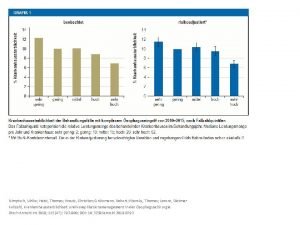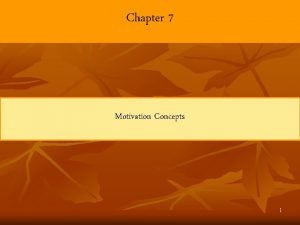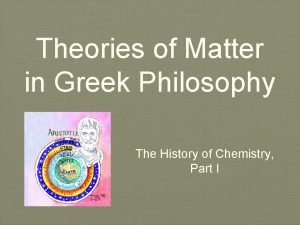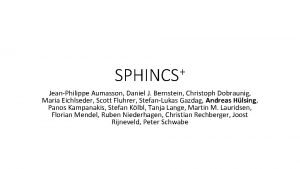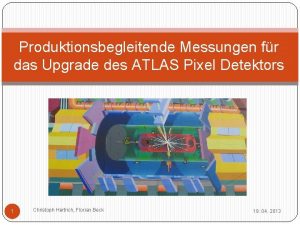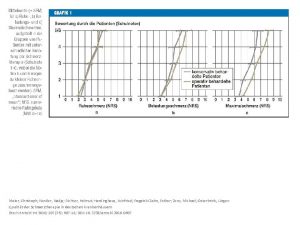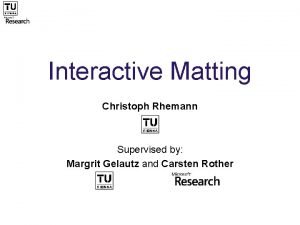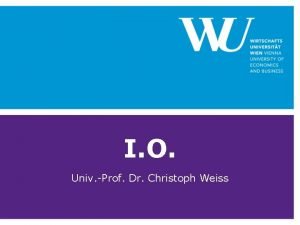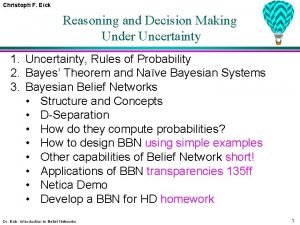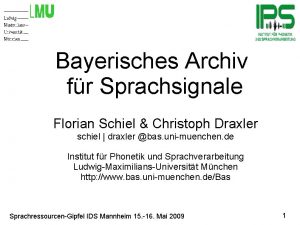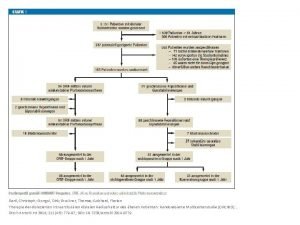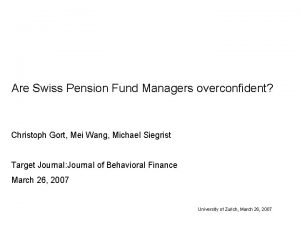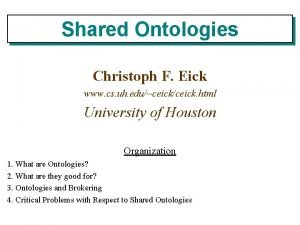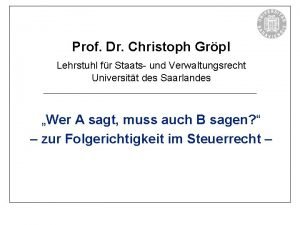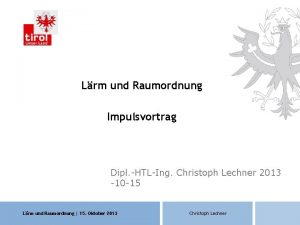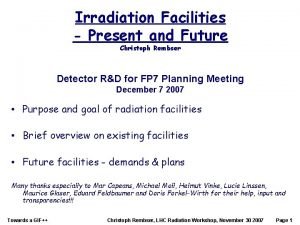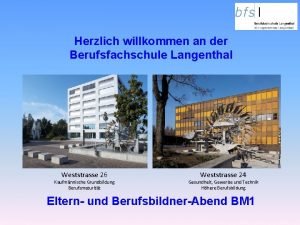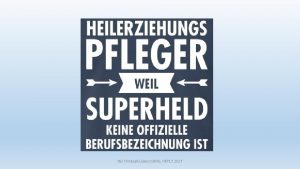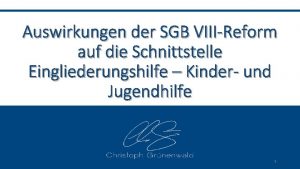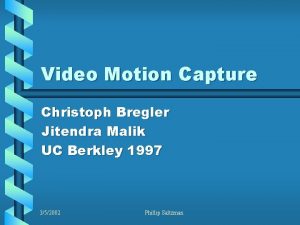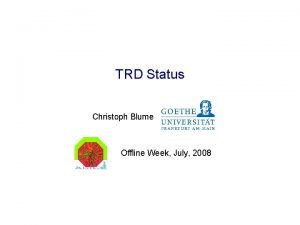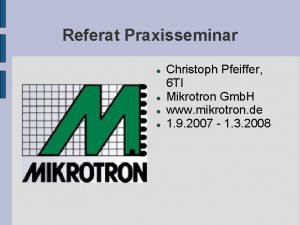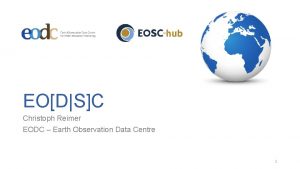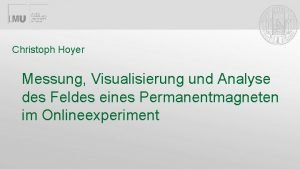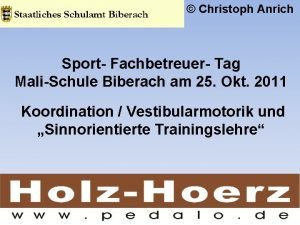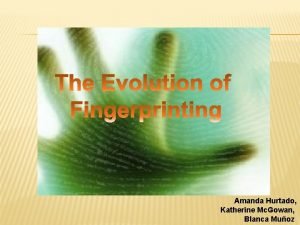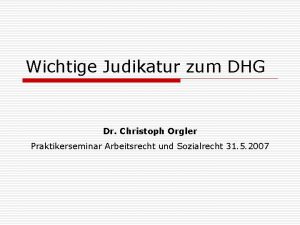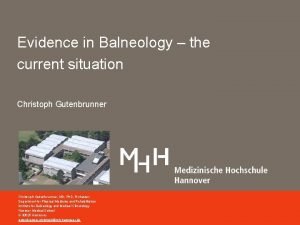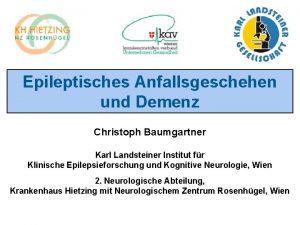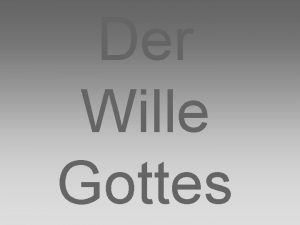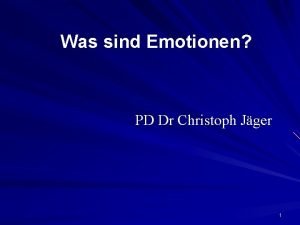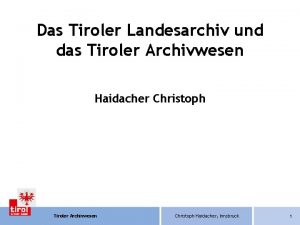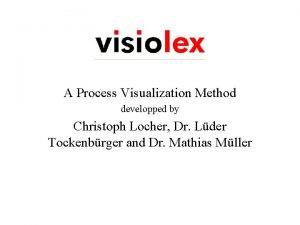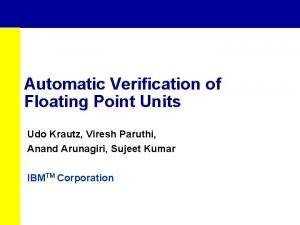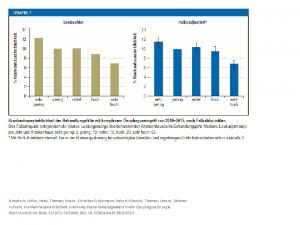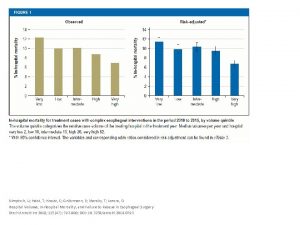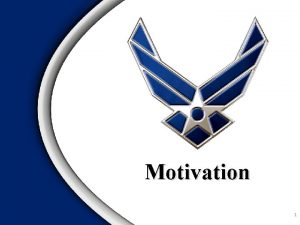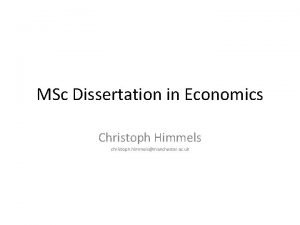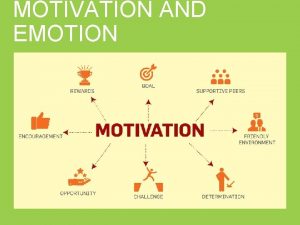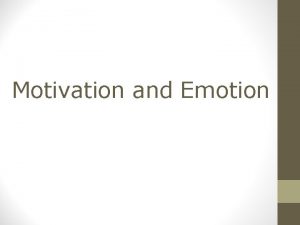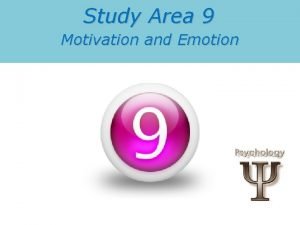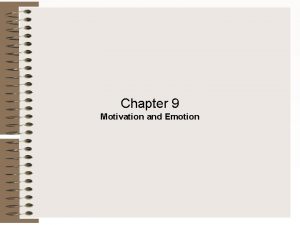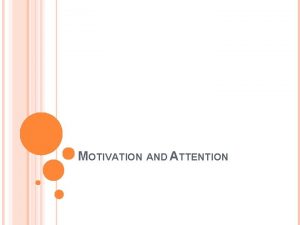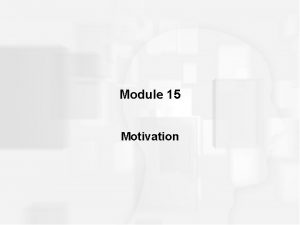Tracking Overview and Mathematics Christoph Krautz Tracking Motivation





![Tracking Motivation Technologies Mathematics Acoustic Tracking n The Geometry From [1] – The intersection Tracking Motivation Technologies Mathematics Acoustic Tracking n The Geometry From [1] – The intersection](https://slidetodoc.com/presentation_image/323555c957e8a65f595a5be80c42fc5e/image-6.jpg)







![Tracking Motivation Technologies Mathematics Inertial Tracking - Gyroscopes From [1] Christoph Krautz 14 Tracking Motivation Technologies Mathematics Inertial Tracking - Gyroscopes From [1] Christoph Krautz 14](https://slidetodoc.com/presentation_image/323555c957e8a65f595a5be80c42fc5e/image-14.jpg)
![Tracking Motivation Technologies Mathematics Inertial Tracking - Gyroscopes Christoph Krautz From [1] 15 Tracking Motivation Technologies Mathematics Inertial Tracking - Gyroscopes Christoph Krautz From [1] 15](https://slidetodoc.com/presentation_image/323555c957e8a65f595a5be80c42fc5e/image-15.jpg)










![Tracking Motivation Technologies Mathematics Inside-out versus Outside-in n Inside-out From [3] Christoph Krautz 26 Tracking Motivation Technologies Mathematics Inside-out versus Outside-in n Inside-out From [3] Christoph Krautz 26](https://slidetodoc.com/presentation_image/323555c957e8a65f595a5be80c42fc5e/image-26.jpg)
![Tracking Motivation Technologies Mathematics Inside-out versus Outside-in n Outside-in From [3] Christoph Krautz 27 Tracking Motivation Technologies Mathematics Inside-out versus Outside-in n Outside-in From [3] Christoph Krautz 27](https://slidetodoc.com/presentation_image/323555c957e8a65f595a5be80c42fc5e/image-27.jpg)


















![Tracking Motivation Technologies Mathematics References: [1] G. Bishop, G. Welch and B. D. Allen, Tracking Motivation Technologies Mathematics References: [1] G. Bishop, G. Welch and B. D. Allen,](https://slidetodoc.com/presentation_image/323555c957e8a65f595a5be80c42fc5e/image-46.jpg)
- Slides: 46

Tracking Overview and Mathematics Christoph Krautz

Tracking Motivation Technologies Mathematics Content n Motivation n Technologies – Advantages and Disadvantages – – – – Common Problems and Errors Acoustic Tracking Mechanical Tracking Inertial Tracking Magnetic Tracking Optical Tracking Inside-out versus Outside-in n Mathematics – Transformations in the 2 D-space – Transformations in the 3 D-space n Discussion Christoph Krautz 2

Tracking Motivation Technologies Mathematics Motivation What is tracking? n The repeated localization of the position and orientation (pose) of one or several real physical objects Why is tracking needed in AR? n Integration of virtual objects into real world (images) Christoph Krautz 3

Tracking Motivation Technologies Mathematics Content n Motivation n Technologies – Advantages and Disadvantages – – – – Common Problems and Errors Acoustic Tracking Mechanical Tracking Inertial Tracking Magnetic Tracking Optical Tracking Inside-out versus Outside-in n Mathematics – Transformations in the 2 D-space – Transformations in the 3 D-space n Discussion Christoph Krautz 4

Tracking Motivation Technologies Mathematics Common Problems and Errors n High update required (usually in real-time systems) n Dynamic tracker error, e. g. sensor‘s motion n Distortion due to environmental influences, e. g. noise n Long-term variations – Cause readings to change from one day to the next day Christoph Krautz 5
![Tracking Motivation Technologies Mathematics Acoustic Tracking n The Geometry From 1 The intersection Tracking Motivation Technologies Mathematics Acoustic Tracking n The Geometry From [1] – The intersection](https://slidetodoc.com/presentation_image/323555c957e8a65f595a5be80c42fc5e/image-6.jpg)
Tracking Motivation Technologies Mathematics Acoustic Tracking n The Geometry From [1] – The intersection of two spheres is a circle. – The intersection of three spheres is two points. • One of the two points can easily be eliminated. n Ultrasonic – 40 [k. Hz] typical Christoph Krautz (Slide taken from SIGGRAPH 2001 Course 11 – Slides by Allen, Bishop, Welch) 6

Tracking Motivation Technologies Mathematics Acoustic Tracking - Methods n Time of Flight – Measures the time required for a sonic pulse to travel from a transmitter to a receiver. – d [m] = v [m/s] * t [s], v = speed of sound – Absolute range measurement n Phase Coherence – Measures phase difference between transmitted and received sound waves – Relative to previous measurement • still absolute!! Christoph Krautz (Slide taken from SIGGRAPH 2001 Course 11 – Slides by Allen, Bishop, Welch) 7

Tracking Motivation Technologies Mathematics Acoustic Tracking – Discussion n Advantages – Small and lightweight (miniaturization of transmitters and receivers) – Only sensitive to influences by noise in the ultrasonic range n Disadvantages – Speed of Sound (~331 [m/s] in air at 0°C) • Varies with temperature, pressure and humidity • Slow Low update rate Christoph Krautz 8

Tracking Motivation Technologies Mathematics Mechanical Tracking n Ground-based or Body-based n Used primarily for motion capture n Provide angle and range measurements – Gears – Bend sensors n Elegant addition of force feedback Christoph Krautz (Slide taken from SIGGRAPH 2001 Course From [1] 11 – Slides by Allen, Bishop, Welch) From [1] 9

Tracking Motivation Technologies Mathematics Mechanical Tracking – Discussion n Advantages – Good accuracy – High update rate – No suffering from environmental linked errors n Disadvantages – Small working volume due to mechanical linkage with the reference Christoph Krautz 10

Tracking Motivation Technologies Mathematics Inertial Tracking n Inertia – Rigidity in space n Newton’s Second Law of Motion – F = ma – M = I (linear) (rotational) n Accelerometers and Gyroscopes – Provide derivative measurements Christoph Krautz 11

Tracking Motivation Technologies Mathematics Inertial Tracking - Accelerometers n Measure force exerted on a mass since we cannot measure acceleration directly. n Proof-mass and damped spring – Displacement proportional to acceleration From [1] n Potentiometric and Piezoelectric Transducers Christoph Krautz (Slide taken from SIGGRAPH 2001 Course 11 – Slides by Allen, Bishop, Welch) 12

Tracking Motivation Technologies Mathematics Inertial Tracking - Gyroscopes n Conservation of angular momentum n Precession – If torque is exerted on a spinning mass, its axis of rotation will precess at right angles to both itself and the axis of the exerted torque Christoph Krautz 13
![Tracking Motivation Technologies Mathematics Inertial Tracking Gyroscopes From 1 Christoph Krautz 14 Tracking Motivation Technologies Mathematics Inertial Tracking - Gyroscopes From [1] Christoph Krautz 14](https://slidetodoc.com/presentation_image/323555c957e8a65f595a5be80c42fc5e/image-14.jpg)
Tracking Motivation Technologies Mathematics Inertial Tracking - Gyroscopes From [1] Christoph Krautz 14
![Tracking Motivation Technologies Mathematics Inertial Tracking Gyroscopes Christoph Krautz From 1 15 Tracking Motivation Technologies Mathematics Inertial Tracking - Gyroscopes Christoph Krautz From [1] 15](https://slidetodoc.com/presentation_image/323555c957e8a65f595a5be80c42fc5e/image-15.jpg)
Tracking Motivation Technologies Mathematics Inertial Tracking - Gyroscopes Christoph Krautz From [1] 15

Tracking Motivation Technologies Mathematics Inertial Tracking - Gyroscopes Christoph Krautz 16

Tracking Motivation Technologies Mathematics Inertial Tracking - Gyroscopes Christoph Krautz 17

Tracking Motivation Technologies Mathematics Inertial Tracking – Discussion n Advantages – Lightweight – No physical limits on the working volume n Disadvantages – Error accumulation due to integration (numerical) • Periodic recalibration – Hybrid systems typical – Drift in the axis of rotation of a gyroscope due to the remaining friction between the axis of the wheel and the bearings Christoph Krautz 18

Tracking Motivation Technologies Mathematics Magnetic Tracking n Three mutually-orthogonal coils – Each transmitter coil activated serially • Induced current in the receiver coils is measured – Varies with » the distance (cubically) from the transmitter and » their orientation relative to the transmitter (cosine of the angle between the axis and the local magnetic field direction) • Three measurements apiece (three receiver coils) • Nine-element measurement for 6 D pose n AC at low frequency n DC-pulses Christoph Krautz (Parts of the slide taken from SIGGRAPH 2001 Course 11 – Slides by Allen, Bishop, Welch) 19

Tracking Motivation Technologies Mathematics Magnetic Tracking – Discussion n Advantages – Small – Good update rate n Disadvantages – Small working volume – Ferromagnetic interference – Eddy currents induced in conducting materials Distortions Inaccurate pose estimates – Use of DC transmitters overcomes that problem – Sensitive to electromagnetic noise Christoph Krautz 20

Tracking Motivation Technologies Mathematics Optical Tracking n Provides angle measurements – One 2 D point defines a ray – Two 2 D points define a point for 3 D position – Additional points required for orientation n Speed of Light – 2. 998 * 108 [m/s] Christoph Krautz From [1] (Slide taken from SIGGRAPH 2001 Course 11 – Slides by Allen, Bishop, Welch) 21

Tracking Motivation Technologies Mathematics Optical Tracking – Active Targets n Typical detectors – Lateral Effect Photo. Diodes (LEPDs) – Quad Cells n Active targets – LEDs From [1] Christoph Krautz 22

Tracking Motivation Technologies Mathematics Optical Tracking – Passive Targets n Typical detectors – Video and CCD cameras • Computer vision techniques n Passive targets – Reflective materials, high contrast patterns From [1] Christoph Krautz 23

Tracking Motivation Technologies Mathematics Optical Tracking – Passive Targets From [A. R. T. Gmb. H] Christoph Krautz 24

Tracking Motivation Technologies Mathematics Optical Tracking – Discussion n Advantages – Good update rate (due to the speed of light) • Well suited for real-time systems n Disadvantages – Accuracy tends to worsen with increased distance – Sensitive to optical noise and spurious light • Can be minimized by using infrared light – Ambiguity of surface and occlusion Christoph Krautz 25
![Tracking Motivation Technologies Mathematics Insideout versus Outsidein n Insideout From 3 Christoph Krautz 26 Tracking Motivation Technologies Mathematics Inside-out versus Outside-in n Inside-out From [3] Christoph Krautz 26](https://slidetodoc.com/presentation_image/323555c957e8a65f595a5be80c42fc5e/image-26.jpg)
Tracking Motivation Technologies Mathematics Inside-out versus Outside-in n Inside-out From [3] Christoph Krautz 26
![Tracking Motivation Technologies Mathematics Insideout versus Outsidein n Outsidein From 3 Christoph Krautz 27 Tracking Motivation Technologies Mathematics Inside-out versus Outside-in n Outside-in From [3] Christoph Krautz 27](https://slidetodoc.com/presentation_image/323555c957e8a65f595a5be80c42fc5e/image-27.jpg)
Tracking Motivation Technologies Mathematics Inside-out versus Outside-in n Outside-in From [3] Christoph Krautz 27

Tracking Motivation Technologies Mathematics Content n Motivation n Technologies – Advantages and Disadvantages – – – – Common Problems and Errors Acoustic Tracking Mechanical Tracking Inertial Tracking Magnetic Tracking Optical Tracking Inside-out versus Outside-in n Mathematics – Transformations in the 2 D-space – Transformations in the 3 D-space n Discussion Christoph Krautz 28

Tracking Motivation Technologies Mathematics Position and Orientation (Pose) n Representation – x, y, z (position) and , , (orientation) – with respect to a given reference coordinate system From [1] Christoph Krautz 29

Tracking Motivation Technologies Mathematics Transformations in the 2 D-space n Translation Y 2 1 1 Christoph Krautz 2 3 X 30

Tracking Motivation Technologies Mathematics Transformations in the 2 D-space n Scale Y 2 1 1 Christoph Krautz 2 3 X 31

Tracking Motivation Technologies Mathematics Transformations in the 2 D-space n Rotation Y Y X 2 1 1 Christoph Krautz 2 3 X 32

Tracking Motivation Technologies Mathematics Transformations in the 2 D-space n Scale and Rotation can be combined by multiplication of their matrices n Translation cannot be combined with them by multiplication n Introduction of Homogeneous Coordinates From [1] Christoph Krautz 33

Tracking Motivation Technologies Mathematics Transformations in the 2 D-space Christoph Krautz 34

Tracking Motivation Technologies Mathematics Transformations in the 3 D-space n Translation Christoph Krautz 35

Tracking Motivation Technologies Mathematics Transformations in the 3 D-space n Scale Christoph Krautz 36

Tracking Motivation Technologies Mathematics Transformations in the 3 D-space n Rotation Christoph Krautz 37

Tracking Motivation Technologies Mathematics Transformations in the 3 D-space n e. g. Rotation through about the z axis Christoph Krautz 38

Tracking Motivation Technologies Mathematics Transformations in the 3 D-space n Rotation-Sequences – Concatenation of several rotations – Can be performed by using • Rotation matrices (matrix multiplication) • Euler-angles • Quaternions Christoph Krautz 39

Tracking Motivation Technologies Mathematics Transformations in the 3 D-space n Euler-angles – Three angles , and • Each represents a rotation about one of the coordinate axes (X, Y and Z). – Gimbal Lock – Ambiguities • R( , 0, 0) = R(0, , ) Christoph Krautz 40

Tracking Motivation Technologies Mathematics Transformations in the 3 D-space n Quaternions n Unit Quaternions n A unit quaternion represents a rotation about the axis through the angle Christoph Krautz 41

Tracking Motivation Technologies Mathematics Transformations in the 3 D-space n Multiplication-operator for quaternions: n The result is a rotation p composed by the rotations q and r. Christoph Krautz 42

Tracking Motivation Technologies Mathematics Transformations in the 3 D-space n Advantages of quaternions: – No gimbal lock – Unique representation of a rotation – Interpolation can be properly carried out (spherical interpolation on the 4 -sphere; Shoemake, 1985) – Rotation-sequences can be easily performed Christoph Krautz 43

Tracking Motivation Technologies Mathematics Conclusion n Each tracking technology has advantages and disadvantages n Multi-Sensor-Fusion for minimizing the measurement errors n Transformations in the 3 D-space have to be handled with care Christoph Krautz 44

Tracking Motivation Technologies Mathematics Thank you for your attention! Any questions? Christoph Krautz 45
![Tracking Motivation Technologies Mathematics References 1 G Bishop G Welch and B D Allen Tracking Motivation Technologies Mathematics References: [1] G. Bishop, G. Welch and B. D. Allen,](https://slidetodoc.com/presentation_image/323555c957e8a65f595a5be80c42fc5e/image-46.jpg)
Tracking Motivation Technologies Mathematics References: [1] G. Bishop, G. Welch and B. D. Allen, „Tracking: Beyond 15 Minutes of Thought”, SIGGRAPH 2001 Course Notes, University of North Carolina at Chapel Hill [2] G. Bishop, G. Welch and B. D. Allen, „Tracking: Beyond 15 Minutes of Thought”, SIGGRAPH 2001 Course Slides, University of North Carolina at Chapel Hill [3] Ribo, Miguel, “State of the Art Report on Optical Tracking”, 2001 Christoph Krautz 46
 Ulrike nimptsch
Ulrike nimptsch Motivation to learn an overview of contemporary theories
Motivation to learn an overview of contemporary theories Christoph luthy
Christoph luthy Christoph dobraunig
Christoph dobraunig Christoph hertrich
Christoph hertrich Christoph nestler
Christoph nestler Margrit gelautz
Margrit gelautz Dr. christoph weiss
Dr. christoph weiss Christoph eick
Christoph eick Christoph draxler
Christoph draxler Christoph stengel
Christoph stengel Christoph gort
Christoph gort Christoph aberle
Christoph aberle Christoph eick
Christoph eick Lehrstuhl gröpl
Lehrstuhl gröpl Christoph hessler
Christoph hessler Dr. christoph lechner
Dr. christoph lechner Christoph rembser
Christoph rembser Berufsfachschule langenthal
Berufsfachschule langenthal Dr christoph haas
Dr christoph haas Bsz christoph lüders
Bsz christoph lüders Christoph grünenwald
Christoph grünenwald Klingspor's stearate discs
Klingspor's stearate discs Christoph malik
Christoph malik Christoph blume
Christoph blume Jan christoph pfeiffer
Jan christoph pfeiffer Christoph reimer
Christoph reimer Christoph kleiser
Christoph kleiser Dr oneta winterthur
Dr oneta winterthur Christoph hoyer
Christoph hoyer Mali schule biberach
Mali schule biberach Nehemiah grew fingerprints
Nehemiah grew fingerprints Orgler rechtsanwalt
Orgler rechtsanwalt Christoph blume
Christoph blume Christoph gutenbrunner
Christoph gutenbrunner Dr christoph baumgartner
Dr christoph baumgartner Christoph beglinger
Christoph beglinger Gottes wille definition
Gottes wille definition Stoa christoph
Stoa christoph Christoph thole
Christoph thole Christoph haidacher
Christoph haidacher Christoph locher
Christoph locher Overview of transcription and translation
Overview of transcription and translation Data cleaning problems and current approaches
Data cleaning problems and current approaches Overview elements and their properties answer key
Overview elements and their properties answer key An overview of data warehousing and olap technology
An overview of data warehousing and olap technology What is bioinformatics an introduction and overview
What is bioinformatics an introduction and overview
